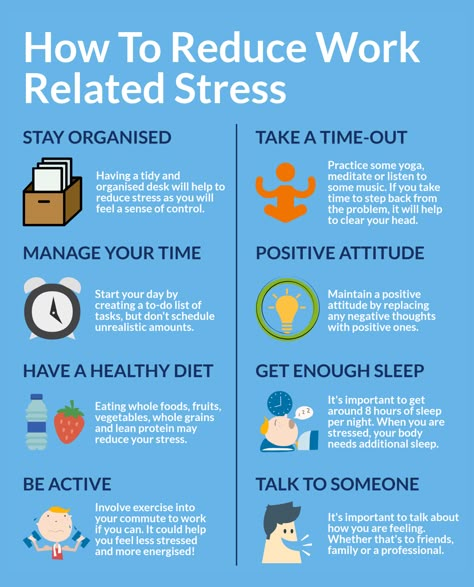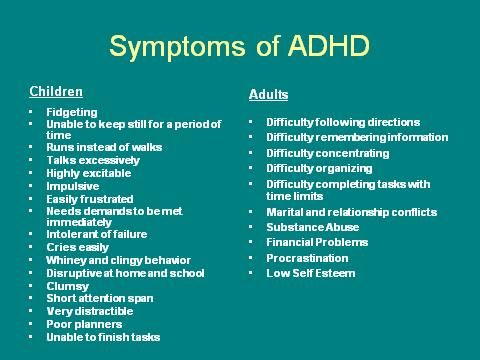Prochaska and diclemente's stages of change model
Prochaska and DiClemente's Stages of Change Model for Social Workers
When life requires a change in directions, sometimes it feels frightening. Changing can be uncomfortable and confusing. Even with a clear goal, the path forward may be hazy. The journey is often difficult and slow and sometimes requires professional help. Clinicians understand this and are trained to help their clients reach their goals by carefully navigating the stages of change. However, counselors need to tailor their assistance to their client's needs, so it's crucial to recognize what stage of change clients are in before deciding how to successfully guide them.
Keep reading to learn more about DiClemente and Prochaska's Stages of Change, one of the most widely adopted models for helping clients make lasting behavioral change. Comprehending the change process, assessing a client's readiness to change and proposing effective ways to achieve change are the primary objectives of the Stages of Change model.
1
The Origins of DiClemente & Prochaska's Stages of Change
During a smoking cessation study in 1983, researchers James Prochaska and Carlo DiClemente identified and developed their Stages of Change as one of the three components in their Transtheoretical Model of Behavior Change, also known simply as TTM. TTM describes the process of change, stages of change and methods of measuring change.1
Five official stages are described in DiClemente and Prochaska's Stages of Change Model, including pre-contemplation, contemplation, preparation, action and maintenance. An unofficial 6th stage, relapse, is popularly included because occasional slips are inevitable in the change process.1
The Stages of Change Model was originally used to help people overcome addictions and problematic behaviors such as alcohol or drug abuse, overeating and smoking.2 However, it is now the "standard-bearer" for change therapy and is also applicable for school bullying, condom use, sunscreen use, exercise adoption and other preventative health measures such as cancer screening and mammography. 3
3
Exploring the Six Stages of Change
Social workers, counselors and other clinicians approach DiClemente and Prochaska's Stages of Change with an understanding that change takes time, varying from one client to another. However, all clients achieve similar stage-specific goals before moving on to the next stage.1 Through each stage, unconditional acceptance and support are offered, together with interventions personalized to a client's unique situation.3
The following paragraphs explore each of the 6 stages of change. Assessment clues are provided, as well as some effective interventions appropriate to each stage.
1. Pre-Contemplation
In the pre-contemplation stage, clients may not recognize the consequences of their actions. Some clients may have been court-ordered or otherwise pressured into treatment. In any case, clients in this stage are typically not considering changing their behavior. Assessment clues include ignorance or denial of problems.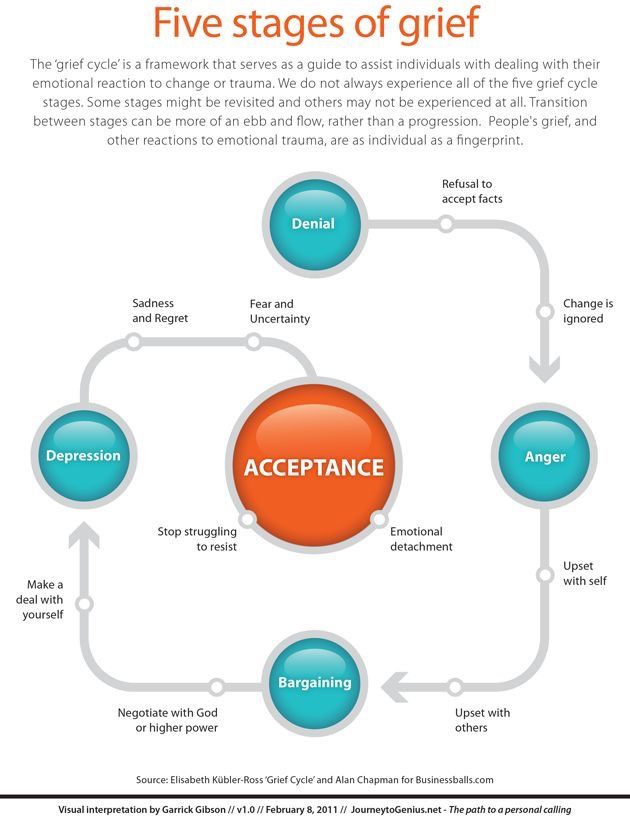 1,4
1,4
Intervention strategies include listening actively, expressing empathy and accepting the client's resistance rather than opposing it. Personalized tasks may include asking clients to reconsider their behavior by analyzing the risks of their actions and identifying any benefits of changing.3,4
2. Contemplation
Clients acknowledge their problem in the contemplation stage but may not have the confidence to take a step forward. Clues to recognizing clients in this stage include uncertainty, conflicted emotions or ambivalence about changing.1,4
Instilling hope in the client's ability to proceed is a crucial form of support in this stage.1 Effective interventions may include asking about a client's beliefs to help gain a deeper understanding of their behavior.3 Asking about possible barriers to change may also be helpful. Clients may gain a stronger sense of purpose by asking them to weigh the pros and cons of present behavior as well as the pros and cons of changing. 2,4
2,4
3. Preparation
In the preparation stage, clients are willing to take small steps forward. Evidence of this stage may include statements confirming a client's commitment to change and a willingness to prepare a plan of action.1,3
Setting small, achievable goals is critical for clients in this stage. Strategic tasks may include identifying resources, supports and skills the client may draw on and then help the client create a plan to attain them. Encourage the client's self-efficacy and commitment to change.1 Clients also need help realistically assessing their level of difficulty during this stage. Considering potential problems and pitfalls can help clients determine solutions and prepare for difficulties ahead of time.2
4. Action
Clients in the action stage have developed clear plans for change and are implementing them. They are easily identified by their direct actions towards accomplishing their goals. 1,4
1,4
As clients become more active, clinicians take on less active roles. The intervention strategies in this stage include periodic reviews of client motivations, resources, progress and enthusiastically praising success. Then, as clients gain greater confidence and ability, counselors provide additional support, advice and guidance only as needed. 1,3
5. Maintenance
Clients enter the maintenance stage after adopting their new change for at least six months. Other identifying factors are unwavering commitment to their change and conscious actions to avoid temptation. They are prepared for potential pitfalls, with well-developed coping skills and support systems.1,3,4
Continuing more as a consultant, the counselor provides advice, guidance and support to clients in the maintenance stage only as needed. People typically remain in this stage for up to 5 years as confidence in sustaining their new lifestyle increases and fear of relapse decreases.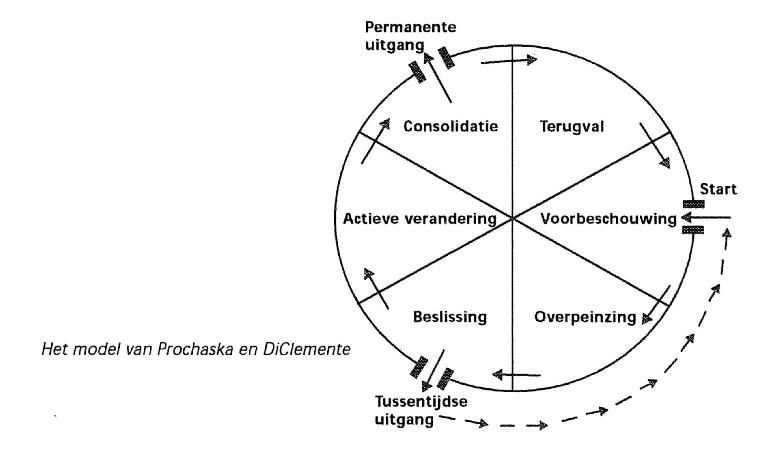 3 Interventions during this stage may include helping clients recognize how overconfidence sometimes leads to relapse. It's also important to promote the mindset that a potential relapse is only a minor setback, not a devastating failure.1
3 Interventions during this stage may include helping clients recognize how overconfidence sometimes leads to relapse. It's also important to promote the mindset that a potential relapse is only a minor setback, not a devastating failure.1
6. Relapse
The unofficial 6th stage of change is relapse. Although termination or completion is the ultimate goal of DiClemente and Prochaska's Stages of Change model, relapses are common in the process of making lifelong changes.3,4 Clients in this stage have lapsed back to old behavior and are easily recognized by their frustration, disappointment or feelings of failure.4
Intervention strategies and tasks include de-stigmatizing and normalizing the notion of relapse, helping the client identify the cause and devising a plan to avoid this trigger in the future. Rebuilding the client's confidence may require restarting the process of change at an earlier stage, such as contemplation, preparation or action.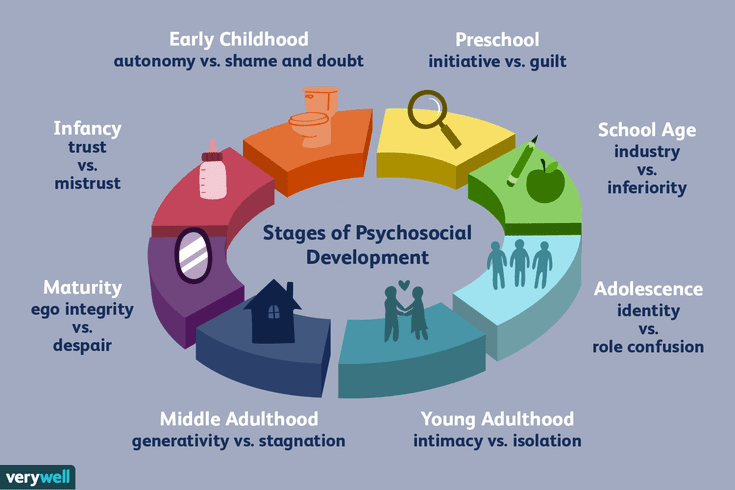 4
4
The keys to success in the relapse stage are helping clients reassess their supports and skills and reaffirm their commitment to their goals. The learning opportunity gained by a relapse very often strengthens a client's resolve and improves the chances for a lifelong change.2,4
Ready to Take Action?
If you're ready to broaden your impact as an enterprising counselor or social worker, this may be the right time for you to take action. Giving you the flexibility and freedom that online learning offers, our 100% online MSW program will help you identify your greatest opportunities for impact by fitting into every stage of your life before, during and after the program.
Consider an online Master of Social Work (MSW) from Yeshiva University. With our CSWE-accredited program, you'll receive the clinical training and field-based skills needed to boost your earning potential and prepare you for building lasting social change.
1.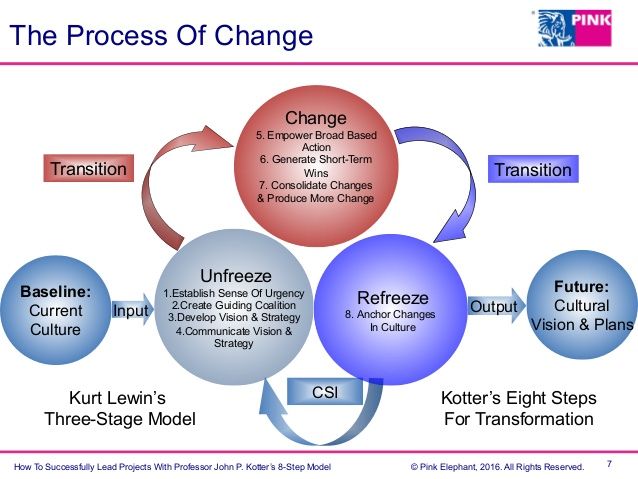 Retrieved on April 22, 2021, from socialworkpodcast.blogspot.com/2009/10/prochaska-and-diclementes-stages-of.html
Retrieved on April 22, 2021, from socialworkpodcast.blogspot.com/2009/10/prochaska-and-diclementes-stages-of.html
2. Retrieved on April 22, 2021, from psychcentral.com/lib/stages-of-change
3. Retrieved on April 22, 2021, from ncbi.nlm.nih.gov/books/NBK556005/
4. Retrieved on April 22, 2021, from verywellmind.com/the-stages-of-change-2794868
The Transtheoretical Model (Stages of Change)
The Transtheoretical Model (also called the Stages of Change Model), developed by Prochaska and DiClemente in the late 1970s, evolved through studies examining the experiences of smokers who quit on their own with those requiring further treatment to understand why some people were capable of quitting on their own. It was determined that people quit smoking if they were ready to do so. Thus, the Transtheoretical Model (TTM) focuses on the decision-making of the individual and is a model of intentional change. The TTM operates on the assumption that people do not change behaviors quickly and decisively.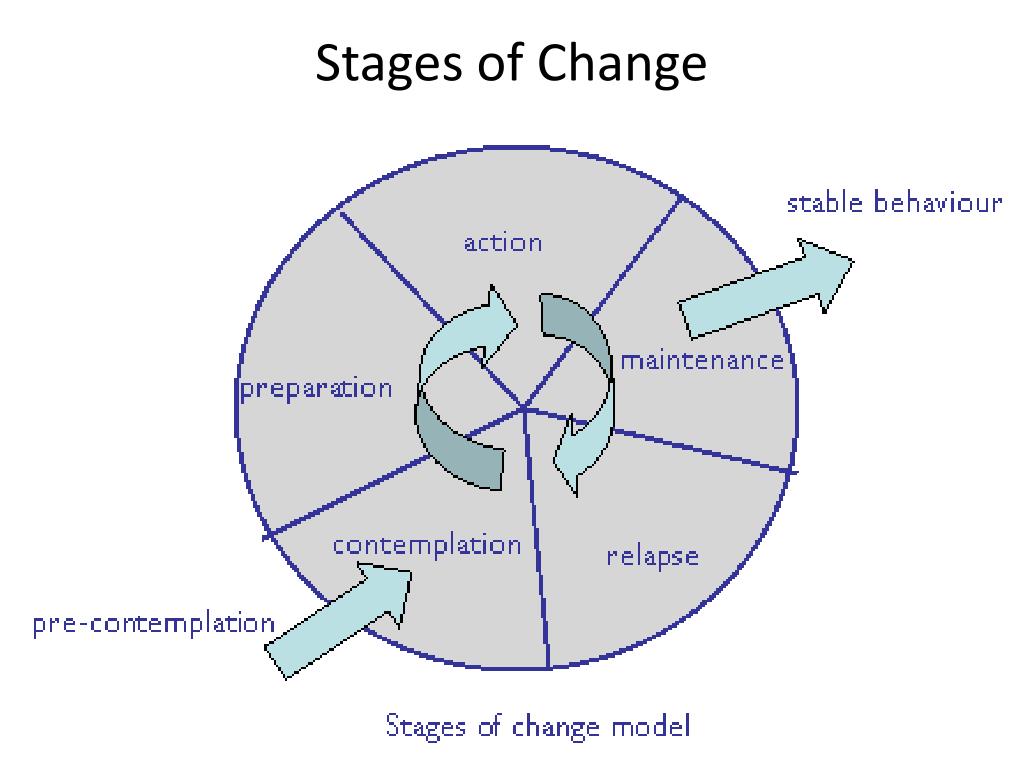 Rather, change in behavior, especially habitual behavior, occurs continuously through a cyclical process. The TTM is not a theory but a model; different behavioral theories and constructs can be applied to various stages of the model where they may be most effective.
Rather, change in behavior, especially habitual behavior, occurs continuously through a cyclical process. The TTM is not a theory but a model; different behavioral theories and constructs can be applied to various stages of the model where they may be most effective.
The TTM posits that individuals move through six stages of change: precontemplation, contemplation, preparation, action, maintenance, and termination. Termination was not part of the original model and is less often used in application of stages of change for health-related behaviors. For each stage of change, different intervention strategies are most effective at moving the person to the next stage of change and subsequently through the model to maintenance, the ideal stage of behavior.
- Precontemplation - In this stage, people do not intend to take action in the foreseeable future (defined as within the next 6 months). People are often unaware that their behavior is problematic or produces negative consequences.
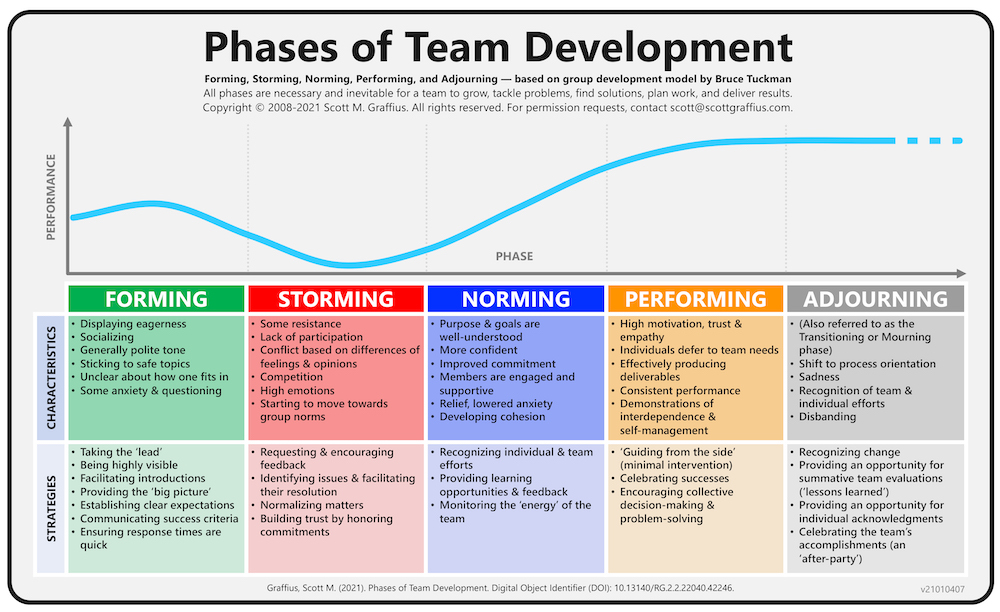 People in this stage often underestimate the pros of changing behavior and place too much emphasis on the cons of changing behavior.
People in this stage often underestimate the pros of changing behavior and place too much emphasis on the cons of changing behavior. - Contemplation - In this stage, people are intending to start the healthy behavior in the foreseeable future (defined as within the next 6 months). People recognize that their behavior may be problematic, and a more thoughtful and practical consideration of the pros and cons of changing the behavior takes place, with equal emphasis placed on both. Even with this recognition, people may still feel ambivalent toward changing their behavior.
- Preparation (Determination) - In this stage, people are ready to take action within the next 30 days. People start to take small steps toward the behavior change, and they believe changing their behavior can lead to a healthier life.
- Action - In this stage, people have recently changed their behavior (defined as within the last 6 months) and intend to keep moving forward with that behavior change.
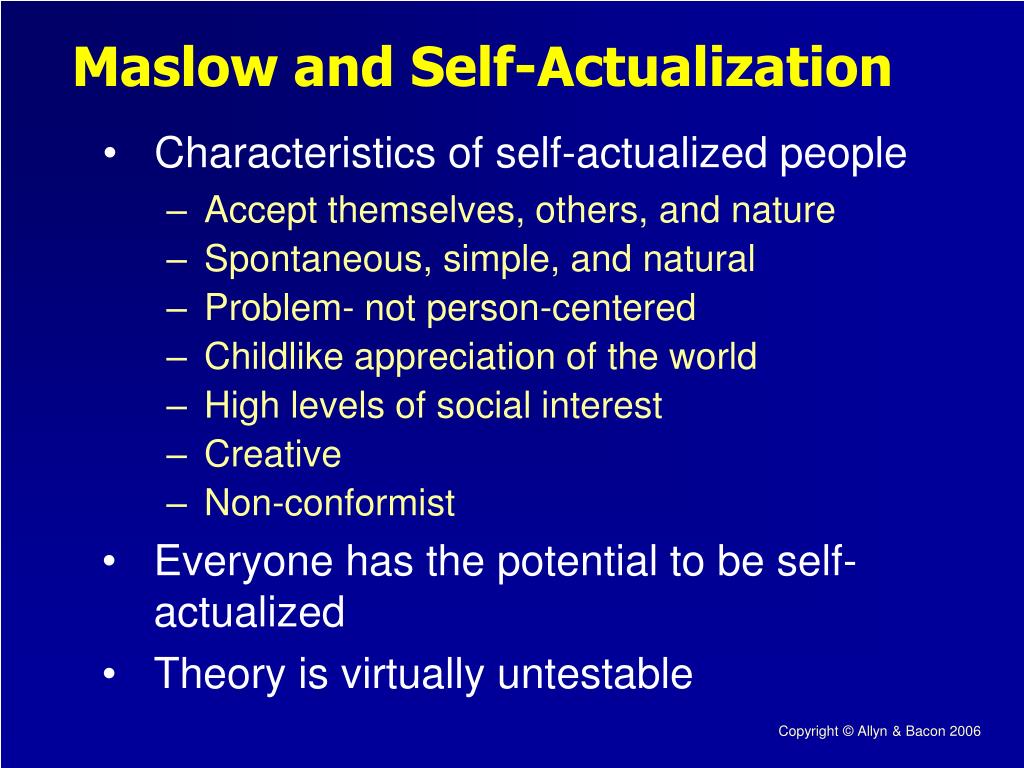 People may exhibit this by modifying their problem behavior or acquiring new healthy behaviors.
People may exhibit this by modifying their problem behavior or acquiring new healthy behaviors. - Maintenance - In this stage, people have sustained their behavior change for a while (defined as more than 6 months) and intend to maintain the behavior change going forward. People in this stage work to prevent relapse to earlier stages.
- Termination - In this stage, people have no desire to return to their unhealthy behaviors and are sure they will not relapse. Since this is rarely reached, and people tend to stay in the maintenance stage, this stage is often not considered in health promotion programs.
To progress through the stages of change, people apply cognitive, affective, and evaluative processes. Ten processes of change have been identified with some processes being more relevant to a specific stage of change than other processes. These processes result in strategies that help people make and maintain change.
- Consciousness Raising - Increasing awareness about the healthy behavior.
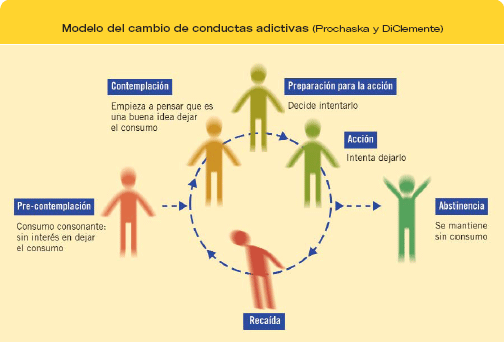
- Dramatic Relief - Emotional arousal about the health behavior, whether positive or negative arousal.
- Self-Reevaluation - Self reappraisal to realize the healthy behavior is part of who they want to be.
- Environmental Reevaluation - Social reappraisal to realize how their unhealthy behavior affects others.
- Social Liberation - Environmental opportunities that exist to show society is supportive of the healthy behavior.
- Self-Liberation - Commitment to change behavior based on the belief that achievement of the healthy behavior is possible.
- Helping Relationships - Finding supportive relationships that encourage the desired change.
- Counter-Conditioning - Substituting healthy behaviors and thoughts for unhealthy behaviors and thoughts.
- Reinforcement Management - Rewarding the positive behavior and reducing the rewards that come from negative behavior.
- Stimulus Control - Re-engineering the environment to have reminders and cues that support and encourage the healthy behavior and remove those that encourage the unhealthy behavior.
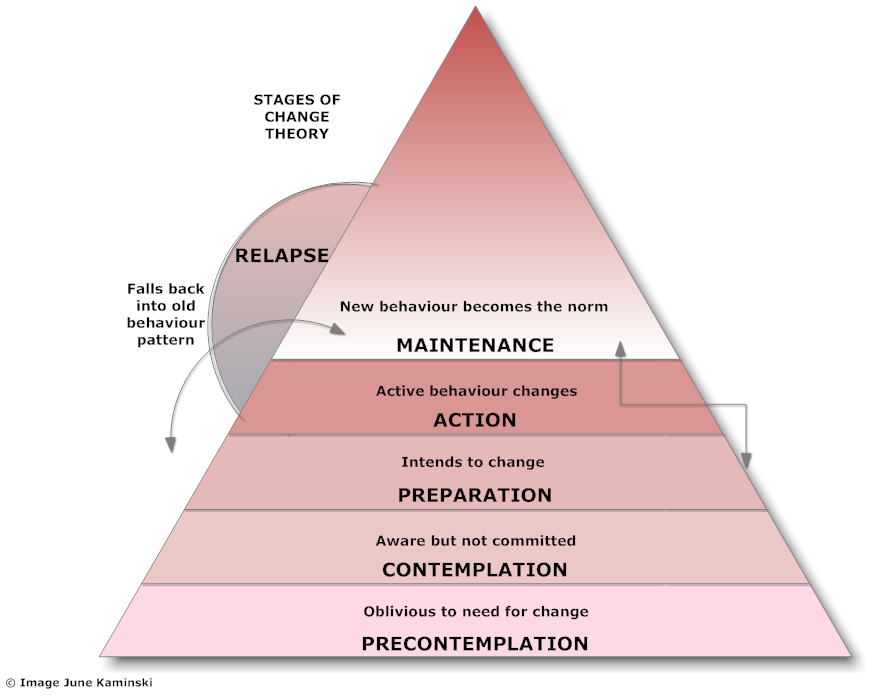
There are several limitations of TTM, which should be considered when using this theory in public health. Limitations of the model include the following:
- The theory ignores the social context in which change occurs, such as SES and income.
- The lines between the stages can be arbitrary with no set criteria of how to determine a person's stage of change. The questionnaires that have been developed to assign a person to a stage of change are not always standardized or validated.
- There is no clear sense for how much time is needed for each stage, or how long a person can remain in a stage.
- The model assumes that individuals make coherent and logical plans in their decision-making process when this is not always true.
The Transtheoretical Model provides suggested strategies for public health interventions to address people at various stages of the decision-making process. This can result in interventions that are tailored (i.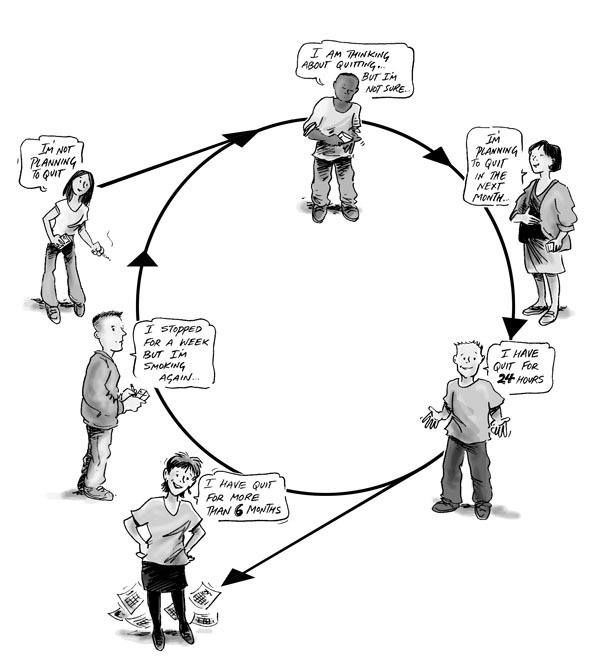 e., a message or program component has been specifically created for a target population's level of knowledge and motivation) and effective. The TTM encourages an assessment of an individual's current stage of change and accounts for relapse in people's decision-making process.
e., a message or program component has been specifically created for a target population's level of knowledge and motivation) and effective. The TTM encourages an assessment of an individual's current stage of change and accounts for relapse in people's decision-making process.
return to top | previous page | next page
how to turn a customer into a loyal customer
If the customer does not know anything about your product, then you will have to spend time and make some effort to sell it. But the strategy of "persuasion step by step" can come to the rescue.
Transtheoretical model of behavior change - persuasion step by step
A comprehensive model that demonstrates changes in human behavior was developed by psychologists J. Prochaska and C. Diclemente in 1994 and described in the work “Stages of change and decision-making balance for 12 problematic types of behavior ". The process of behavior change has been studied from the point of view of various theories, so the model is called transtheoretical.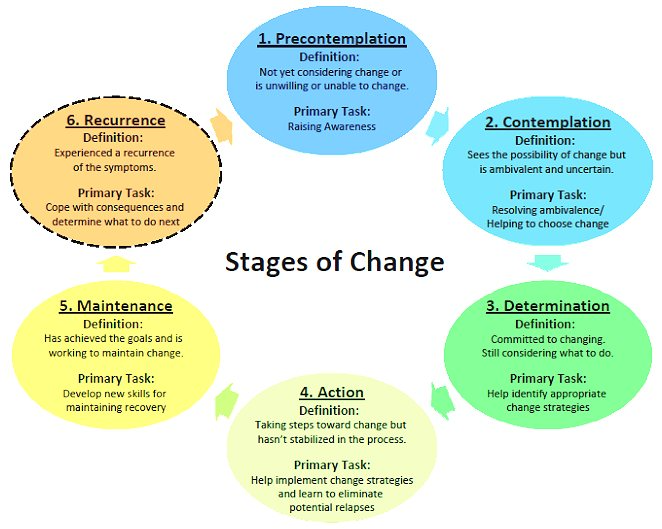
J. Prochasca and C. Diclemente
The transtheoretical model is a comprehensive multifactorial concept of the process of changing human behavior. The possibilities of practical use of the transtheoretical model are enormous. It is used in a variety of areas - from the fight against smoking and overweight to the prevention and fight against juvenile delinquency.
It has also been widely used in marketing. Using this model, you can extremely effectively influence the behavior of consumers, turning them into repeat customers.
The community is now on Telegram
Subscribe and stay up to date with the latest IT news
Subscribe
5 stages of the step-by-step persuasion strategy
How to make the consumer move from the stage of completely ignoring your product to the stage of transformation integral part of his life? How to start an advertising campaign and effectively reach the planned result? The transtheoretical model of persuasion is here to help!
The transtheoretical model has 5 stages.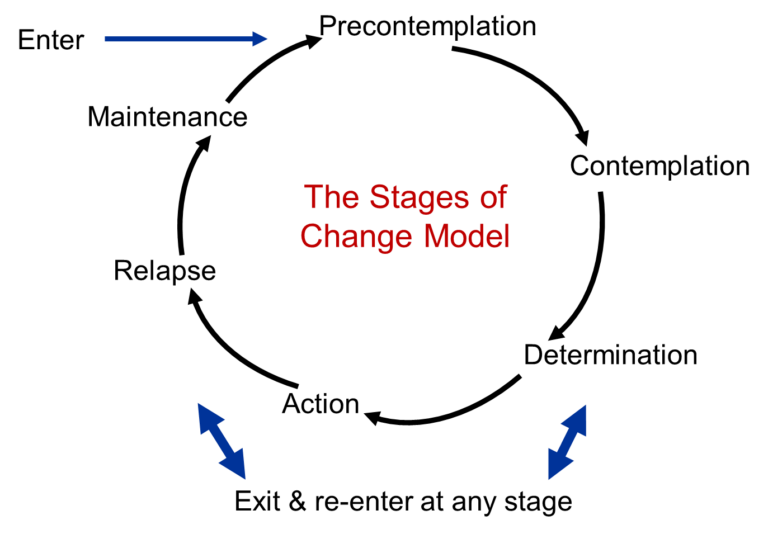 Each stage assumes a certain level of knowledge of the consumer about the product and behavior corresponding to this level of knowledge.
Each stage assumes a certain level of knowledge of the consumer about the product and behavior corresponding to this level of knowledge.
Consider the passage of these stages by the consumer on a specific example. Let's say you have an online school for creating websites. You teach web site development from scratch to PRO level. You train front-end, back-end and full-stack developers (full-cycle developers). Your courses teach programming languages such as HTML, CSS, JavaScript, PHP, Java, C, Python, Ruby, work with libraries and databases, and also equip you with advanced technologies. You have a serious professional approach to learning. After training, your students are not only capable of simple projects, they are also able to implement really complex things developed in a pure programming language. Your courses are not that easy to learn, but you solve this problem by using a radical new author's teaching method on which your learning system is based. If you do not have such a unique technique, develop it.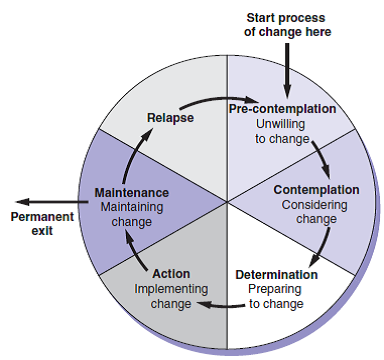 You position yourself as an authoritative expert who thoroughly knows what he teaches.
You position yourself as an authoritative expert who thoroughly knows what he teaches.
Stage 1: Prethinking
At this stage, the consumer does not yet have the intention to change anything in his life. He doesn't know anything about your product and avoids situations that could change his behavior. He does not show interest in new products and is not inclined to discuss them. A person exaggerates the positive aspects of his course of action and underestimates the benefits of another product.
Stage 2: Thinking
In the contemplation stage, a person is already considering the possibility of changing his behavior. At this stage, the consumer studies the product, usually evaluates the pros and cons as approximately equal, and they are equally important to him. The results are still unpredictable.
At this stage, potential buyers are already aware of the existence of your product and are considering the prospect of using it: “Maybe you should try this course. But writing code yourself... It's hard. Apparently, some basic knowledge, some training are needed.
But writing code yourself... It's hard. Apparently, some basic knowledge, some training are needed.
Stage 3: Preparation
The preparation stage is characterized by the fact that the person already has the intention to change his attitude towards the product in the near future. He may have made some attempts, but now he is clearly taking more confident steps towards changing the attitude towards your product. At the preparation stage, the pros already outweigh the cons, although both are still important to the consumer. Empirical ways of thinking are used by him more and more intensively.
This is the planning phase. Your potential buyer is already thinking about purchasing your product, but he still needs some information about its advantages and benefits: “I would like to buy this course ... Tired of making business card sites already! Yes, and money from them ... Probably, after completing the course, I will be able to take on complex projects.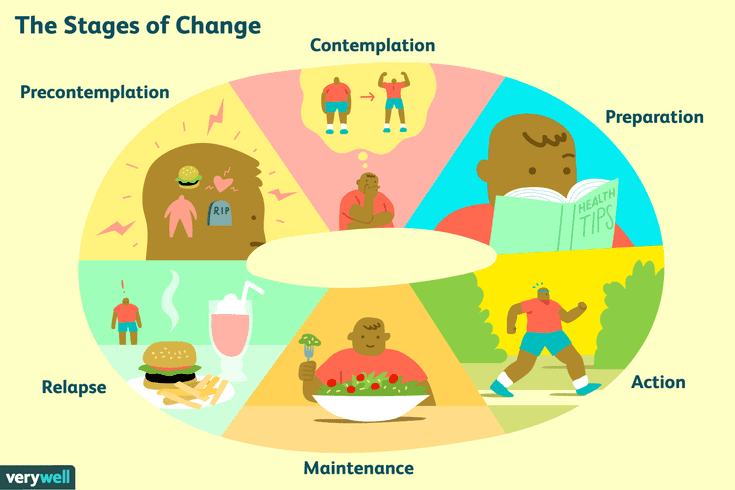 A completely different client will come to me. Bring more money! If there is a desire, I can get a decent job. The prospects are tempting... But what is this course? Why is it better and more useful than others? What is the miraculous system of education? Or is it really easier? Will I be able to handle it?"
A completely different client will come to me. Bring more money! If there is a desire, I can get a decent job. The prospects are tempting... But what is this course? Why is it better and more useful than others? What is the miraculous system of education? Or is it really easier? Will I be able to handle it?"
Stage 4: Action
The action stage indicates a decisive change in behavior and is characterized by the stable maintenance of a new style of behavior. But the problem of relapse, a return to the previous behavior, still persists, although it is no longer so acute.
Success! Your potential buyer has come to the phase of the desired action, that is, the purchase: “Here is my credit card, give me this rate already!”.
Stage 5: Maintenance
At this stage, the behavioral change is obvious, the likelihood of unwanted behavior is very low, and there is no return to the past.
The best phase in which you would like to always see potential customers.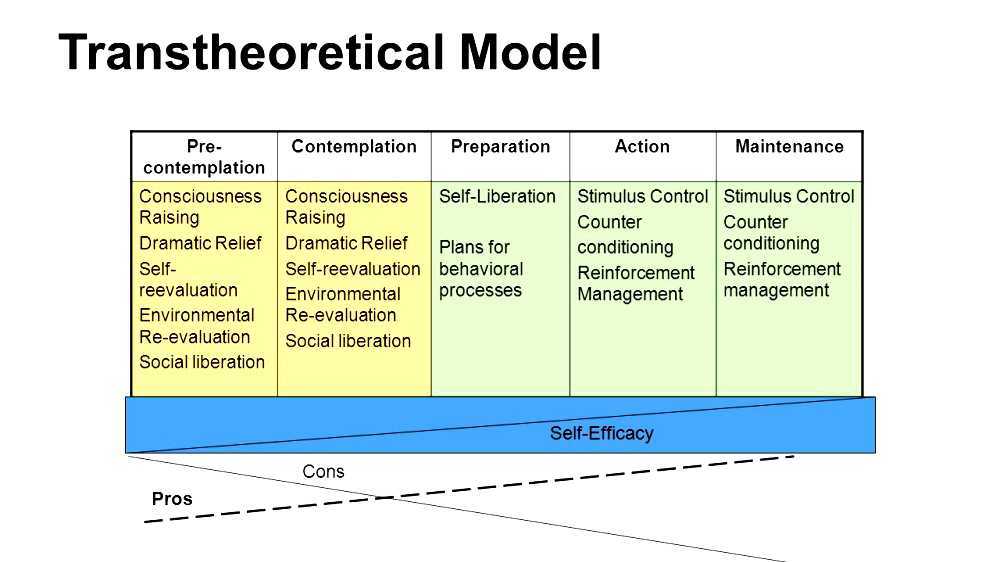 At this stage, your product has already become part of the daily life of customers. They continue, without hesitation, to buy your courses. It is your courses that they choose. Everything is extremely simple: when they want to go further, when they want to improve their professional level, acquire new knowledge, master new programming languages and reach new heights in web development, they come to you.
At this stage, your product has already become part of the daily life of customers. They continue, without hesitation, to buy your courses. It is your courses that they choose. Everything is extremely simple: when they want to go further, when they want to improve their professional level, acquire new knowledge, master new programming languages and reach new heights in web development, they come to you.
How to Apply the Step by Step Persuasion Strategy
Your goal is to gradually guide your customers through all 5 stages so that using your product becomes a habit and a necessary part of their life.
What is the difficulty in applying this strategy? The difficulty is that you need to successfully interact with groups of consumers who are at different stages of the process of getting to know your product. Some of your potential buyers are in the first stage, and others do not even think about other courses, having reached the fifth.
You have two options:
- Come up with an ad that appeals to consumers in all five stages. This will allow potential buyers to focus on the stage that is currently relevant for them. Just include in your ad everything that the consumer needs to form an idea about your product, form an opinion, and make a purchase decision.
- Create a series of commercials (ads) that will replace each other after some time, moving from stage 1 to stage 5. Thus, the first video (ad) will introduce your product to the market, and each subsequent video (ad), based on on the previous one, will highlight the key benefits and benefits of your product.
This way you can lead your potential customers through all 5 stages of behavior change, providing enough information and motivation to become regular customers.
The application of this strategy is extremely effective, as it aims to develop an attitude of long-term and stable preference for your product to others.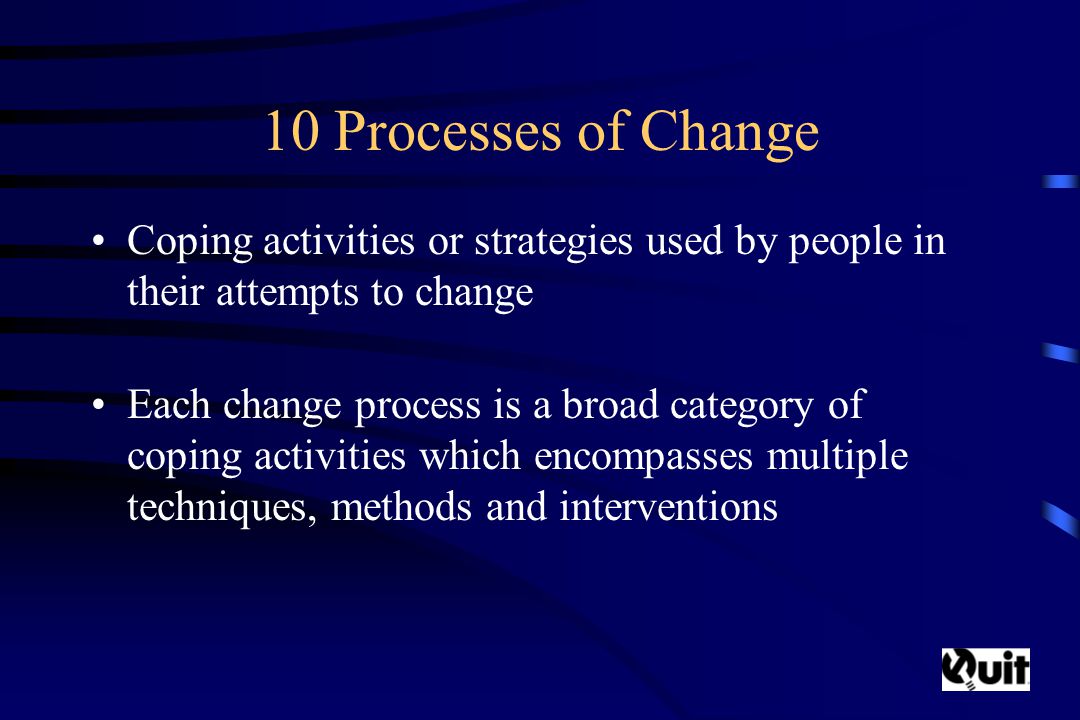 Using your product becomes a habit and becomes vital. Try it, and the desired results will not be long in coming.
Using your product becomes a habit and becomes vital. Try it, and the desired results will not be long in coming.
Want a loyal customer to stay with you for the rest of your life? Then we need to work a little more and strengthen the conquered frontiers and heights. And there is another strategy for this.
Theory of vaccination. Be chosen for life
Inoculation theory (attitude inoculation) uses methods that can increase people's confidence in their own beliefs and help maintain their position in the face of undesirable outside influences.
The vaccination theory was developed by Yale University social psychologist William J. McGuire, who was looking for an answer to the question of whether it is possible to give "vaccinations against unwanted information exposure" by analogy with vaccinations against viral diseases. The mechanism of the inoculation theory is similar to the medical process of vaccination. A medical vaccine consists of weakened virus cells. After the introduction of the vaccine, the human body begins to fight, producing antibodies, and defeats the virus, becoming immune to it. With medical inoculation, a dose of antigenic material is introduced, and when applying the theory of inoculation, doses of information are offered that contradict the existing ideas of man.
Information that contains a small threat to a person's beliefs helps develop "immunity" to such messages and allows you to successfully defend your position in a more serious attack, strengthening confidence in beliefs.
In marketing, grafting theory is used to reinforce a consumer's existing opinion of a product by presenting a weak "against" argument that forces the buyer to defend his position, put forward counterarguments, and become increasingly convinced of the correctness of his opinion.
Three stages of the vaccination strategy
Let's go back to the online school of website building. Let's take an example. Analyzing the activities of competitors, you notice that someone is selling a course on a topic similar to yours at a lower price. This fact is already eloquently told by a competitor's advertisement. You are well aware that when comparing the price, a potential buyer may prefer the rate of competitors, since it is cheaper.
You have reviewed the course content of your competitors and concluded that your course provides significantly more information on the topic. Your course reveals it more fully, the material is better structured, there are much more practical exercises that are a logical continuation of the theoretical blocks.
The use of a vaccination strategy will help to communicate your conclusions to consumers and justify the high price. One way to use grafting theory is to publish critical assessments of competitors in the form of weak attacks and turn those assessments into your own advantage.
Make the starting point of your actions the competitor's claim that their price is the lowest in the market and that all others offer similar courses at a higher price. And then use the vaccination strategy.
The theory of inoculation involves three stages.
Warn of an approaching attack
Start a discussion on your site. Write: “Competitors say that our course is expensive, that they can offer a similar one at a lower price. But they don’t say anything about the fact that their course is completely devoid of three important theoretical blocks (write their names) and 10 practical lessons on them, which are necessary for developing skills... Perhaps, if we remove these three blocks and 10 practical lessons, we We can make our course even cheaper than our competitors.”
Your task at this step is to warn users of the impending danger and provoke a response. You must force them to prepare for a possible attack: strengthen the defense and prepare counterarguments.
Weak Attack
In this step, you begin to attack lightly. Stir up your audience with a few weak arguments in favor of what you are planning to do: “Maybe we could go for a way to shorten the course, remove some topics and practical exercises. This will probably deprive our students of the opportunity to acquire certain knowledge and skills, but it will make the course cheaper. These topics can be given for independent study ... So what do you think?
Encourage fierce defense
This strategy will get your users to say whatever they think about it. The inoculation strategy will force users to think critically, become more aware of their position, strengthen their defenses, and prepare for a counterattack.
Note that it is important not to overdo it here. Your attack must be convincing but weak. Non-essential arguments against beliefs contribute to the development of defensive counter-arguments that strengthen confidence in the correctness of one's position. Otherwise, you risk achieving the opposite effect and changing the opinion of potential buyers about your product.
Thus, by applying the vaccination strategy, you can refute all the advertising arguments of your competitors. If you provide reliable information, then your advertising becomes something more than just another advertising cry. This enhances your credibility. You are pushing potential customers to pass all the words of your competitors through your filter.
Such advertising leads to the fact that there are more and more critical buyers who are inclined to purchase your products. Think about what you do faster, better and easier? Inoculate potential customers by bringing these benefits to the surface and watch how you win them over.
A universal model for changing lives for the better
I am often approached for help by people who do not know how to change. One client, I'll call her Chloe, compared her life to the classic film Groundhog Day. “Every day seems like a repeating cycle. The same problems occur, just at different times. I start the morning with the best intentions, and by the evening I feel tired. I promise myself that tomorrow will be better. But everything always repeats itself,” she said.
Shot from the film Groundhog Day
Chloe's inability to change has nothing to do with low intelligence. She graduated from a prestigious university and headed the development department in a promising startup. Objectively, she knew what steps to take to remedy the situation. But she was afraid to take action.
When clients come to me with a problem like Chloe's, I explain to them that change is a process that takes time. Once you understand the stages of this process, determine where you are now and how to move forward, you can change something.
Steps in the change process
In the early 1980s, psychologists James Prochaska and Carlo Diclemente developed a model to explain how behavior change occurs. According to their transtheoretical model, people are at different stages of readiness for change.
There are five stages of change:
- Prethinking: no real intention to act.
No thought about the consequences of inaction.
- Pondering: realizing the problem. Intention to take action, but lack of clear enthusiasm.
- Preparation: intention to take action within a month. Preparing for change.
- Action: transition to actions to change behavior.
- Maintenance: successful changes for six months or more. Confidence in their abilities and a desire to continue changing behavior.
Once you have established your position in the change process, you can begin to follow certain practical steps that will help you move forward until you achieve the desired result.
If you take action before you are mentally and emotionally ready, you will obviously fail. Certain strategies work best at a certain stage.
A few years ago I tried to convince my father to eat better and exercise more because he had problems with blood pressure. He didn't see weight loss as a solution, instead he started taking medication.
Photo: Unsplash
My attempts to explain to him about the consequences of obesity only increased the tension between us. He thought that I taught him and misunderstood him. I felt offended because it seemed to me that he was ignoring me.
Nothing changed until the doctor warned him about the risk of diabetes. Only then did he decide to change his eating habits. Since then, he has lost 30 kg, twice a week he goes to the mountains. He had to be ready and internally motivated to go through the first three stages and finally take action. If I had known about the transtheoretical model at the time, I would have done things differently.
Understanding the process of change and where you are at will help you make progress.
Rating: What stage are you at?
You can assess where you are with the Ready Bar method.
On a scale of zero to ten, answer these two questions:
- How important is change to me right now?
- How confident do I feel about changing my behavior now?
If the score is:
- From zero to three, you are in the prethinking stage.
- From four to seven - you are at the stage of reflection and want to make changes within the next six months.
- Above eight - you are at the stage of preparation or even action.
Stage 1: Prethinking
People in this stage do not intend to take action in the next six months. They either do not understand or deliberately ignore the consequences of their behavior. Resistance or defensive reaction are signs of precontemplation.
Photo: Unsplash
People at this stage are characterized by a “defeatist attitude”. Often they say, “Oh, that’s just me” or “I can’t [go to the gym/start traveling] because I’m too busy. ” This is how they try to justify their behavior. Often such people overestimate what it will cost them to change their behavior and underestimate the benefits. Sometimes it takes an ultimatum from a lover/beloved to get a person at the precontemplation stage to think differently.
Practice Steps
For one week, try to pay attention to your inner dialogue and the stories you tell yourself. How often do you say you can't do something? Do you say something like “I will never get better” or “The result is always the same. Why try then?"
Such internal conversations are the result of cognitive distortions: thinking traps, systematic errors that prevent us from thinking rationally.
Cognitive biases that occur during the prethinking stage include:
- Mental filtering: selecting one negative consequence and focusing on it. For example, focusing on food that you will have to give up, or on the stressors that a promotion at work will entail.
- Overgeneralization: the belief that you will fail because you have failed in the past. For example, you may forego dating in bars because of a bad experience, limiting your ability to meet new good people in the future.
- Minimizing the Positive: At the precontemplation stage, it is very easy to minimize the benefits of change and the role of your personal strengths. Instead, you focus on your weaknesses or failures.
These thought traps force wrong beliefs on you and prevent you from making progress. How to deal with them?
- Look for examples of situations where you excelled at something.
- Think about the benefits of changing habits.
- I also love asking clients to talk about something good that is happening in their lives. So they begin to think positively without going into defensive mode.
- If you find yourself saying "yes, but.
..", replace "but" with "and". For example, "yes, but a promotion means I'll have to give presentations more often, which I really don't like" would become "yes, a promotion means I'll have to give more presentations and I'll have more opportunities for product design, and I've dreamed about it for years." Rejoice in new opportunities.
Stage 2: Contemplation
In the contemplation stage, you begin to seriously think about the difficulties you may encounter and how to overcome them. You want change but aren't sure where to start.
My client Chloe was at this stage. She saw the problem, but did not know how to improve the situation and what to start with first.
Photo: Unsplash
People can get stuck in this stage for a long time. The advantages and disadvantages of change seem to be equal, and this can lead to ambivalence.
However, at this stage you begin to imagine how your life could change for the better. You are closer to accepting that the effort is worth it. You begin to want change - and not because someone is forcing you.
Practical Steps
If you want to increase intrinsic motivation, identify your values.
One of my clients, Jacob, found out that beauty was one of his core values. Then he understood why his gray little office evoked negative emotions in him. He made small changes - he bought a few plants, and during breaks he went out into the streets to get some fresh air. As a result, he began to feel much better.
Thinking people are open and receptive to new information. To move to action, it is also helpful to find a coach or mentor. The lessons of people who have succeeded in life can give you confidence.
Stage 3: Preparation
In this stage, you begin to change behavior. Perhaps you sign up for a gym or buy the necessary equipment. Or you start to clear your mind and space and donate clothes to charity or give papers from your desk for recycling.
Practical Steps
Now is the time to make a plan for dealing with the obstacles that might prevent you from reaching your big goal.
- Make a strategy for how you will protect yourself from distractions and temptations.
- Build an environment around you that will promote success.
- Build confidence by celebrating victories, even small ones.
- Imagine that you have reached your goal and make a list of the obstacles you might encounter along the way. Make an if/then plan to prepare for internal or external challenges that may arise along the way.
New York University researchers Gabriel Oettingen and Peter Gollwitzer describe the planning process as follows:
- Desire - Describe what changes you want to achieve next month. (I want to start drawing again).
- Outcome - Determine the best possible outcome and write it down in detail.
(I feel at peace when I paint after work. By the end of each month, I will finish painting a picture).
- Obstacle - Take into account internal and external obstacles that may interfere with you. (I don't have tools. Other than that, I'm blocked at work).
- Plan - now make an if/then plan, which will indicate how you will deal with obstacles. (I'll ask my boss at 3:00 pm what I need to do and I won't have to stay in the office. I'll order my painting tools.)
Photo: Unsplash
Stage 4: Action
Time to act! A person at this stage is ready for change and begins to live differently.
You write 500 words a day, go to the gym or meet new people to promote your business. Your results may not be significant so far, but you are confident and have the knowledge necessary for continued success.
Practical steps
The main thing is to keep the momentum going. Follow the if/then plan when you encounter problems.
Impostor syndrome can also occur at this stage as you step out of your comfort zone and take risks. Don't let perfectionism hold you back. You don't have to do everything perfectly - just treat failures as feedback. Change your way of thinking:
- Examine Your Expectations - If you are lost on what you should and shouldn't do, answer the questions: "What would it be like if it were easy?" or “How can I make this activity interesting?”
- Act like a scientist - give yourself at least 20 hours to try a new habit. According to research, this is enough time to master a new skill.
- Focus on the present - Instead of worrying about dieting for the next five years, think about what a healthy meal you can eat today.
- Check yourself regularly - Self-awareness is very important throughout the process, especially at this stage.
It is very easy to get carried away with actions and forget about values and long-term goals. Take time to reflect on your actions.
Support is very important at this stage. Go to meetups, join groups and communities on Facebook to find like-minded people.
Stage 5: Maintenance
Now you are confident. The new behavior has become an integral part of your life. Desired changes now require no effort; this is your daily routine.
Photo: Unsplash
It is at this stage that people tend to relapse. Important life events, stress and old habits can set you back.
Prochaska and Diclemente found that approximately 15% of people relapse into the maintenance stage and revert to the prethinking stage. 85% of them find the strength to take action again.
Practical Steps
Behavior change is all about enjoying life. But you won't be able to do this if you're constantly exhausted. During the maintenance phase, it is important to avoid barriers such as boredom, procrastination, and overwork.
Stress can undermine your mood, so find out what is causing it. What situations anger or annoy you the most? Only in this way can you anticipate your reaction to a problem and develop more effective solutions.
For most, the biggest risk is burnout. There is no one size fits all solution to avoid this, but you can control it:
- Create an opportunity for physical, mental and emotional recovery.
- Come up with rituals to help you transition from work mode to rest mode.
- Set strict time limits and say "no" to anything that doesn't align with your priorities.
- Communicate with family and friends and, if necessary, explain to them that you need support or freedom.
- Break your goals down into smaller steps, such as five minutes of meditation or writing 100 words a day.






